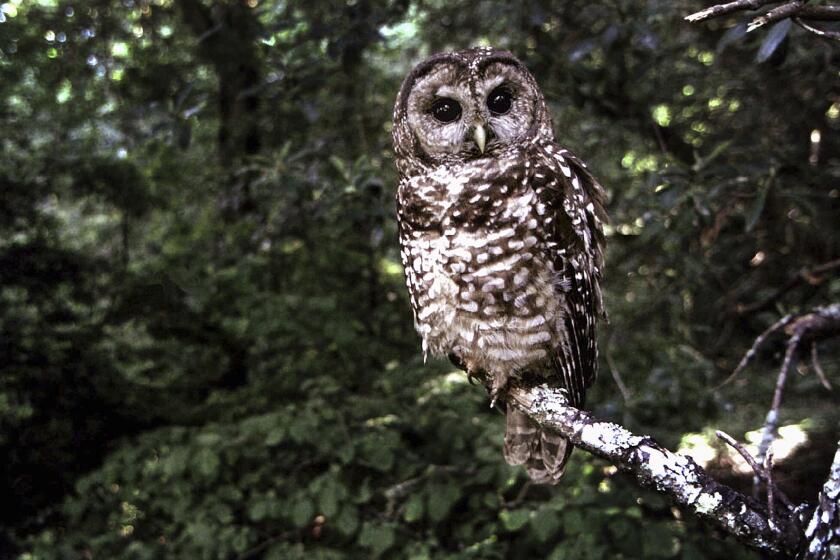Largely Intact Mastodon Fossil Found in Hemet
- Share via
HEMET — As bulldozers and earthmovers roared in the background Wednesday, paleontologists at the construction site of a reservoir were gingerly unearthing what they say might be the most complete mastodon skeleton ever found in Southern California.
The fossil was discovered late last month by an earthmover slashing through clay in a valley just south of the small Riverside County town of Hemet, where water officials hope to create Southern California’s largest reservoir. Fortunately, a team of paleontologists was on hand and recognized the bone.
Not only is the discovery, announced Wednesday, scientifically valuable for the new information it could give about the Southern California climate and wildlife of eons ago, it puts the town of Hemet on the paleontological map.
“This is great PR for us,” said Quintin Lake, a paleontologist with the San Bernardino County Museum who was working on the skeleton Wednesday. “We’re not just finding small bits and pieces, but now we can prove that we can find the showy stuff. It’s not just people back east or in South Dakota.
“This,” he added, “is the brass ring.”
The skeleton is the second-largest found in Southern California. The largest such skeleton was found at the same site, called the Eastside Reservoir Project, in October 1995. But that skeleton was only about 10% intact.
The new find is at least 40% intact, and only about half unearthed. The beast’s bottom remains buried in clay, so scientists hope the specimen will be even more complete.
“Little Stevie,” as the fossil has been dubbed, is one of about 3,000 fossils found in the valley being excavated to create the Eastside Reservoir. The San Bernardino County Museum team watching the excavation and collecting the fossils says it is a region that can be compared to--and possibly exceeds--the La Brea Tar Pits for paleontological richness.
“Little Stevie” may be the strongest piece of evidence collected at the Eastside Reservoir Project that the record of prehistoric life preserved in the La Brea Tar Pits--the record relied upon in Southern California for dozens of years--was an anomaly, said Eric Scott, field supervisor of the paleontological team.
*
La Brea, he noted, was an unusual area that preserved skeletons of mostly predators who fed upon animals trapped in the pits. In Hemet, Scott said, there is a fuller cross-section.
When the project began in 1993, a paleontologist hired by the Metropolitan Water District predicted that there would be virtually no fossils underneath the Domengoni valley where the reservoir would be dug. But once the digging began, the San Bernardino County paleontologists found dozens of species that had never been found in inland California.
Among them were so many mastodon fragments that the area was dubbed “Valley of the Mastodons.” But intact mastodon fossils were elusive.
The fossils will enable scientists to piece together a picture of prehistoric life in the Inland Empire and how large mammals may have migrated across North America. In October 1995, they discovered “Max,” the largest mastodon found in California, which measured 10 feet tall at its shoulder.
That was a larger elephant than paleontologists had expected. California mastodons were believed to be significantly smaller than their East Coast and Midwestern cousins. But since no whole skeleton had been found, scientists were still searching for answers.
Late in the afternoon of June 29, Steve Kesler found them.
Kesler, also a paleontologist from the San Bernardino museum, was ending his 10-hour shift when the earthmover tore a trench in clay at the eastern end of the valley. He noticed what appeared to be a rib bone poking out of the dirt, and marked off the area to be carefully excavated by a night crew of paleontologists.
Kesler went home, only to be called later that night by excited paleontologists who told him: “We’re finding a lot more than just rib fragments.”
The next day, six paleontologists dug out the head, a tusk, a shoulder and the pelvis of the mastodon, finding the skull of an extinct horse, an ancient sloth and a bear along the way.
“It was awesome,” Kesler said.
In honor of Kesler, they dubbed the beast “Little Stevie.” But it is not that little--an estimated 9 1/2 feet at the shoulder, the mastodon would have weighed about four tons.
Scott said “Little Stevie”--estimated to be in his late teens or early 20s at the time of his demise--shows that “Max” was not an anomaly, and that California mammoths were truly behemoths.
When fully excavated and preserved at the museum, it may also allow paleontologists to settle a longtime question: whether California mastodons were indeed the same species as their East Coast brethren. Until now, Scott said, there has not been a skeleton intact enough to fully study.
The elation was contagious at the excavation site Wednesday, as construction workers and members of the local Chamber of Commerce came by to snap pictures and paleontologists sliced away at clay with gusto, despite the heat.
“This is unbelievably important,” Scott said. “None of us expected this. You can get down on your knees and pray for this sort of thing, but it doesn’t usually help.”
More to Read
Sign up for Essential California
The most important California stories and recommendations in your inbox every morning.
You may occasionally receive promotional content from the Los Angeles Times.










